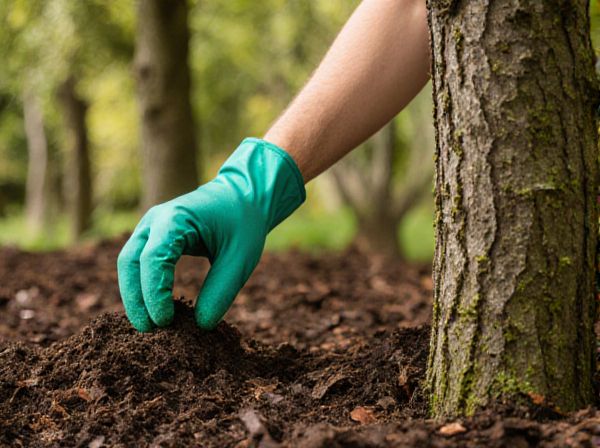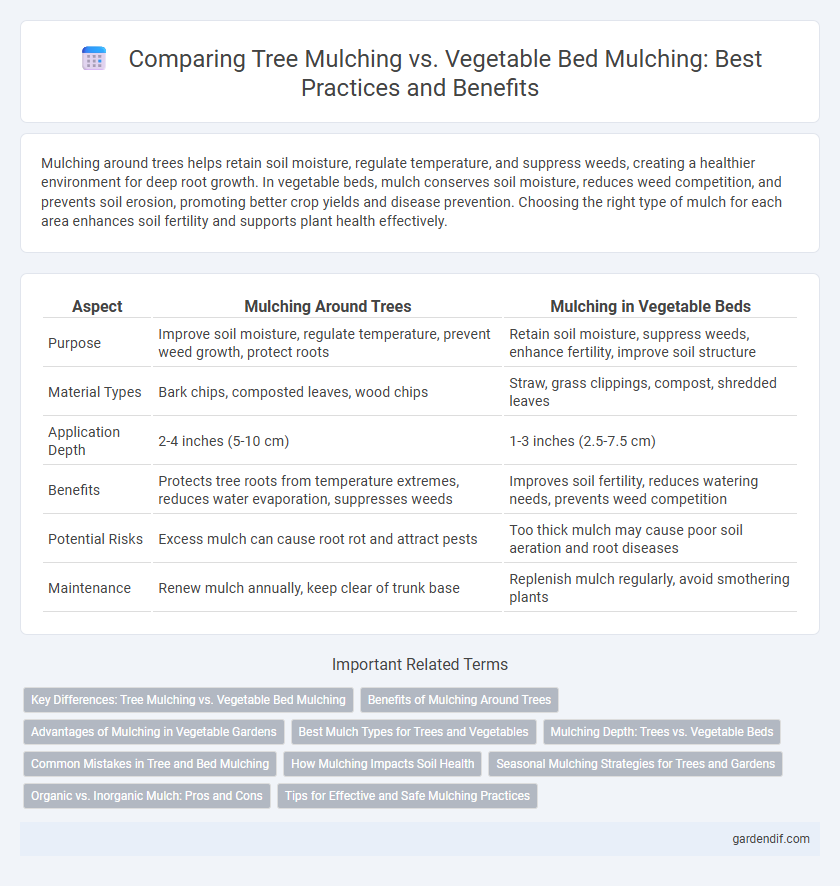
Mulching around trees vs Mulching in vegetable beds Illustration
Mulching around trees helps retain soil moisture, regulate temperature, and suppress weeds, creating a healthier environment for deep root growth. In vegetable beds, mulch conserves soil moisture, reduces weed competition, and prevents soil erosion, promoting better crop yields and disease prevention. Choosing the right type of mulch for each area enhances soil fertility and supports plant health effectively.
Table of Comparison
| Aspect | Mulching Around Trees | Mulching in Vegetable Beds |
|---|---|---|
| Purpose | Improve soil moisture, regulate temperature, prevent weed growth, protect roots | Retain soil moisture, suppress weeds, enhance fertility, improve soil structure |
| Material Types | Bark chips, composted leaves, wood chips | Straw, grass clippings, compost, shredded leaves |
| Application Depth | 2-4 inches (5-10 cm) | 1-3 inches (2.5-7.5 cm) |
| Benefits | Protects tree roots from temperature extremes, reduces water evaporation, suppresses weeds | Improves soil fertility, reduces watering needs, prevents weed competition |
| Potential Risks | Excess mulch can cause root rot and attract pests | Too thick mulch may cause poor soil aeration and root diseases |
| Maintenance | Renew mulch annually, keep clear of trunk base | Replenish mulch regularly, avoid smothering plants |
Key Differences: Tree Mulching vs. Vegetable Bed Mulching
Mulching around trees primarily focuses on moisture retention, temperature regulation, and weed suppression to support long-term root health, often using organic materials like wood chips or bark that decompose slowly. In vegetable beds, mulch serves to protect soil moisture, prevent erosion, and suppress weeds but requires more frequent replenishment due to faster decomposition and nutrient needs of annual plants, commonly utilizing straw, grass clippings, or compost. The key difference lies in the mulch type and maintenance frequency, driven by the distinct growth cycles and environmental requirements of trees versus vegetables.
Benefits of Mulching Around Trees
Mulching around trees improves soil moisture retention, reduces weed growth, and stabilizes soil temperature, promoting healthier root development and overall tree vitality. It also prevents mechanical damage to tree trunks by keeping lawn equipment at a safe distance and enriches the soil as organic mulch decomposes. Compared to vegetable beds, tree mulching requires thicker layers to protect long-term root systems and supports mature tree structures.
Advantages of Mulching in Vegetable Gardens
Mulching in vegetable gardens improves soil moisture retention, reduces weed growth, and enhances soil temperature regulation, leading to healthier plant development and higher yields. Organic mulches like straw or compost also contribute essential nutrients as they decompose, promoting long-term soil fertility. This practice minimizes erosion and prevents soil compaction, creating optimal conditions for root growth and nutrient uptake in vegetable beds.
Best Mulch Types for Trees and Vegetables
Organic mulches such as shredded bark, wood chips, and composted leaves are ideal for mulching around trees, promoting root health and moisture retention without suffocating the soil. In vegetable beds, lightweight mulches like straw, grass clippings, and black plastic mulch effectively suppress weeds, regulate soil temperature, and retain moisture for optimal vegetable growth. Choosing mulch types tailored to trees and vegetables enhances soil fertility, conserves water, and supports sustainable garden practices.
Mulching Depth: Trees vs. Vegetable Beds
Proper mulching depth varies significantly between trees and vegetable beds due to root system differences and moisture needs. For trees, a mulch depth of 3 to 4 inches helps retain soil moisture, regulate temperature, and suppress weeds without suffocating roots, whereas vegetable beds benefit from a thinner 1 to 2-inch layer to balance moisture retention with adequate soil aeration and prevent root rot. Over-mulching trees beyond 4 inches can cause anaerobic conditions and pest issues, while insufficient mulch in vegetable gardens may lead to rapid soil drying and increased weed growth.
Common Mistakes in Tree and Bed Mulching
Applying mulch too thickly around trees can suffocate roots and promote disease, while inadequate mulch depth in vegetable beds fails to suppress weeds effectively. Using wood-based mulch close to tree trunks often leads to moisture retention that encourages rot, whereas applying mulch directly against vegetable stems can cause stem rot and pest issues. Common mistakes include neglecting mulching layer adjustments for seasonal changes and choosing inappropriate mulch types that do not match the specific needs of trees or vegetable plants.
How Mulching Impacts Soil Health
Mulching around trees creates a protective barrier that retains soil moisture, suppresses weed growth, and encourages beneficial microbial activity, which enhances nutrient cycling and root health. In vegetable beds, mulching helps regulate soil temperature, reduces erosion, and maintains optimal moisture levels, promoting robust plant growth and improving soil structure. Both practices enrich organic matter content and foster a balanced soil ecosystem, ultimately leading to improved soil fertility and crop yield.
Seasonal Mulching Strategies for Trees and Gardens
Seasonal mulching around trees involves applying organic materials like wood chips or shredded bark in early spring to conserve moisture, regulate soil temperature, and suppress weeds, while refreshing the mulch layer in late fall to protect roots from winter cold. In vegetable beds, seasonal mulching utilizes straw or compost to improve soil fertility, retain moisture during hot summer months, and reduce erosion, with mulching applied after planting and replenished as crops mature. Tailoring mulching strategies to the specific needs of trees and garden vegetables enhances growth and resilience throughout the changing seasons.
Organic vs. Inorganic Mulch: Pros and Cons
Organic mulch, such as wood chips or straw, enhances soil fertility and moisture retention when applied around trees, promoting healthy root development and microbial activity. In vegetable beds, organic mulch also suppresses weeds and improves soil structure, but requires regular replenishment due to decomposition, unlike inorganic mulch like plastic or rubber, which provides longer-lasting weed control and moisture conservation but may hinder soil aeration and beneficial organism activity. Selecting between organic and inorganic mulch depends on the specific plant needs, soil health goals, and maintenance preferences for trees versus vegetable beds.
Tips for Effective and Safe Mulching Practices
Mulching around trees requires maintaining a 2-4 inch layer of organic material, avoiding direct contact with the trunk to prevent moisture buildup and pest infestation. In vegetable beds, a thinner mulch layer of about 1-2 inches is ideal to retain soil moisture, suppress weeds, and allow proper airflow to the roots. Regularly monitoring mulch thickness and replenishing as needed optimizes soil health and plant growth while minimizing risks such as root rot or fungal diseases.
Mulching around trees vs Mulching in vegetable beds Infographic

 gardendif.com
gardendif.com